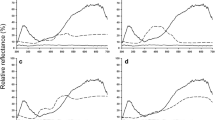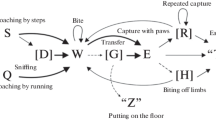Summary
Carabid species of the visually hunting type living in dim habitats have larger frontal ommatidia and gain their optimal visual performance with lower light intensity than species inhabiting bright places.
The latter phenomenon is based upon the mechanisms of light adaptation, which reduce the acceptance angles of the ommatidia thus increasing their visual acuity. In more sensitive ommatidia adaptation occurs with lower light intensity.
The differences between the species concerning the intensity dependence of their visual performance are regarded as an effect of natural selection. Thereafter an apposition eye more sensitive to light should be advantageous in a dim environment.
This hypothesis has been investigated and verified by observation of the predation behaviour of Notiophilus biguttatus confronted with Collembola: From 1 to 500 lux the hunting success of the beetles increased proportionally to the light intensity.
Measurements of the activity at dawn and at dusk under natural conditions showed that the beginning and the conclusion of activity are correlated with a critical level of illumination. Notiophilus biguttatus starts being active if the illumination is sufficient for successful hunting.
Similar content being viewed by others
References
Anderson, J.M.: Food and feeding of Notiophilus biguttatus F. (Coleoptera: Carabidae). Rev. Ecol. Biol. Sol. 9, 177–184 (1972)
Bauer, Th.: Ethologische, autökologische und ökophysiologische Untersuchungen an Elaphrus cupreus Dft. und Elaphrus riparius L. (Coleoptera, Carabidae). Oecologia (Berl.) 14, 139–196 (1974)
Bauer, Th.: Zur Biologie und Autökologie von Notiophilus biguttatus F. und Bembidion foraminosum Strm. (Coleopt., Carabidae) als Bewohner ökologisch extremer Standorte. Zool. Anz., Jena 194, 305–318 (1975)
Bauer, Th., Völlenkle, W.: Hochfrequente Filmaufnahmen als Hilfsmittel bei der Analyse von Angriffs-und Fluchtverhalten in einer Räuber-Beute-Beziehung unter Bodentieren (Collembolenfang visuell jagender Carabiden). Wiss. Film (Wien) 17, 4–11 (1976)
Blackith, R.E.: Visual sensitivity and foraging in social wasps. Insectes Sociaux 5, 159–169 (1958)
Bott, R.: Beiträge zur Kenntnis von Gyrinus natator. II. Der Sehapparat. Z. Morph. Ökol. Tiere 10, 206–306 (1928)
Bowden, J., Haines, I.H., Mercer, D.: Climbing Collembola. Pedobiologia 16, 298–312 (1976)
Brunner, G.: Über die Sehschärfe der Elritze (Phoxinus laevis) bei verschiedenen Helligkeiten. Z. vergl. Physiol. 21, 296–316 (1935)
Burkhardt, D., Darnhofer-Demar, B., Fischer, K.: Zum binokularen Entfernungssehen der Insekten. 1. Die Struktur des Sehraumes von Synsekten. J. comp. Physiol. 87, 165–188 (1973)
Clark, L.B.: The visual acuity of the fiddler crab, Uca pugnax. J. gen. Physiol. 19, 311–319 (1935)
Davies, M.J.: The contents of the crops of some British Carabid beetles. Ent. mon. Mag. 89, 18–23 (1953)
Davies, M.J.: A contribution to the ecology of species of Notiophilus and allied genera (Col., Carabidae). Ent. mon. Mag. 95, 25–28 (1959)
Ehrenhardt, H.: Formensehen und Sehschärfebestimmungen bei Eidechsen. Z. vergl. Physiol. 24, 248–304 (1937)
Ernsting, G., Joosse, E.N.G.: Predation on two species of surface dwelling Collembola: a study with radio-isotope labelled prey. Pedobiologia 14, 222–231(1974)
Exner, S.: Die Physiologie der facettierten Augen von Krebsen und Insekten. Leipzig-Wien: Deuticke 1891
Franceschini, N., Kirschfeld, K.: Le contrôle automatique du flux lumineux dans l'œil composé des Diptères. Biol. Cybernetics 21, 181–203 (1976)
Gavel, L.v.: Die kritische Streifenbreite als Maß der Sehchärfe bei Drosophila melanogaster. Z. vergl. Physiol. 27, 80–135 (1939)
Greenslade, P.J.M.: Daily rhythms of locomotory activity in some Carabidae (Coleoptera). Ent. exp. appl. 6, 171–180 (1963)
Hassenstein, B.: Ommatidienraster und afferente Bewegungsintegration. Z. vergl. Physiol. 33, 302–326 (1950)
Hecht, S., Wald, G.: The visual acuity and intensity discrimination of Drosophila. J. gen. Physiol. 17, 517–547 (1934)
Hecht, S., Wolf, E.: The visual acuity of the honey bee. J. gen. Physiol. 12, 727–760 (1929)
Himstedt, W.: Experimentelle analyse der optischen Sinnesleistungen im Beutefangverhalten der einheimischen Urodelen. Zool. Jb. Physiol. 73, 281–320 (1967)
Home, E.M.: The fine structure of some Carabid beetle eyes, with particular reference to ciliary structures in the retinula cells. Tissue & Cell 8, 311–333 (1976)
Horridge, G.A.: Alternatives to superposition images in clear-zone compound eyes. Proc. R. Soc. Lond. B. 179, 97–124 (1971)
Horridge, G.A., Giddings, C.: Movement on dark-light adaptation in beetle eyes of the Neuropteran type. Proc. R. Soc. Lond. 179, 73–85 (1971)
Kabacik-Wasylik, D.: Studies on the diet of three field species of Carabidae. Ekol. Pol. 19, 502–508 (1971)
Kasischke, P.: Freiland-und Laborversuche zur Aktivitätsrhythmik der tagaktiven Carabiden eines Waldbiotops (mit besonderer Berücksichtigung der Gattung Notiophilus). Staatsexamensarbeit, Köln (1975)
Koehler, H.: Nahrungsspektrum und Nahrungskonnex von Pterostichus oblongopunctatus (F.) und Pterostichus metallicus (F.) (Coleoptera, Carabidae). Verhdl. Ges. Ökol. Göttingen 1976. The Hague: Junk (in press)
Kolb, G., Autrum, H.J.: Die Feinstruktur im Auge der Biene bei Hell-und Dunkeladaptation. J. comp. Physiol. 77,113–125 (1972)
Lindroth, C.H.: Die fennoskandischen Carabidae. Kungl. Vetensk Vitterh. Samh. Handling., Ser. B4 (1945/49); No. 1, Spezieller Teil (1945)
Luff, M.L.: Adult and larval feeding habits of Pterostichus madidus (F.) (Coleoptera, Carabidae). J. natur. Hist. 8, 403–409 (1974)
Manske, U., Schmidt, U.: Visual acuity of the Vampire bat, Desmondus rotundus and its dependence upon light intensity. Z. Tierpsychol. 42, 215–221 (1976)
Meyer-Rochow, V.B.: Fine structural changes in dark-light adaptation in relation to unit studies of an insect compound eye with a Crustacean rhabdom. J. Ins. Physiol. 20, 573–589 (1974)
Schaller, F.: Notiophilus biguttatus und Japyx solifugus als spezielle Collembolenräuber. Zool. Jb. Abt. System., Ökol. u. Geogr. 78, 194–296 (1949)
Stavenga, D.G., Kuiper, J.W.: Insect pupil mechanisms. 1. On The pigment migration in the retinula cells of Hymenoptera (Suborder Aprocrita). J. comp. Physiol. 113, 55–72 (1977)
Stavenga, D.G., Numan, J.A.J., Tinbergen, J., Kuiper, J.W.: Insect pupil mechanisms. 2. Pigment migration in retinula cells of butterflies. J. comp. Physiol. 113, 73–93 (1977)
Thiele, H.: Über die Facettenaugen von land-und wasserbewohnenden Crustaceen. Z. Morphologie 69, 9–22 (1971)
Wachmann, E., Schröer, W.-D.: Zur Morphologie des Dorsal-und Ventralauges des Taumelkäfers Gyrinus substriatus (Steph.) (Coleoptera, Gyrinidae). Zoomorphologie, 82, 43–61 (1975)
Walcott, B.: Cell movement on light adaptation in the retina of Lethocerus (Belostomatidae, Hemiptera). Z. vergl. Physiol. 74, 1–16 (1971a)
Walcott, B.: Unit studies on receptor movement in the retina of Lethocerus (Belostomatidae, Hemiptera). Z. vergl. Physiol. 74, 17–25 (1971b)
Williams, G.: Seasonal and diurnal activity of Carabidae, with particular reference to Nebria, Notiophilus and Feronia. J. anim. Ecol. 28, 309–330 (1959)
Author information
Authors and Affiliations
Additional information
Supported by the Deutsche Forschungsgemeinschaft
Supported by the Österreichischer Forschungsrat
Rights and permissions
About this article
Cite this article
Bauer, T., Brauner, U. & Fischerleitner, E. The relevance of the brightness to visual acuity, predation, and activity of visually hunting ground-beetles (Coleoptera, Carabidae). Oecologia 30, 63–73 (1977). https://doi.org/10.1007/BF00344892
Received:
Issue Date:
DOI: https://doi.org/10.1007/BF00344892




